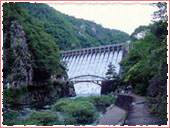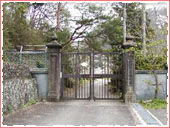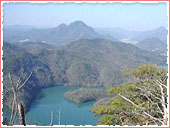![]()
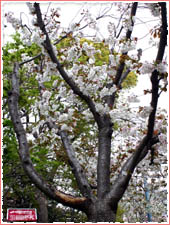
The Okamoto Minami Park is a five-minute walk north of the Hankyu Okamoto station. The park is also called Sakura-mori Park since it was used as the setting of the Tsutomu Minakami's novel entitled Sakura-mori. The park is run by the Kobe city government and was built on the grounds that had housed the former mansion owned by Shintaro Sasabe. He was a well-known collector of cherry trees and worked all his life in preserving cherry trees found growing uncultured in their natural habitat. Inside the park there are 30 cherry trees in 10 varieties with signs giving details about each variety. There is a mountain variety cherry tree named Sasabe-zakura in honor of Sasabe that has been designated a natural commemorative item by the Hyogo Prefecture.
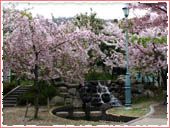
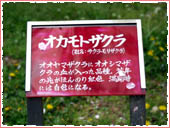
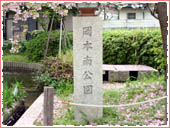
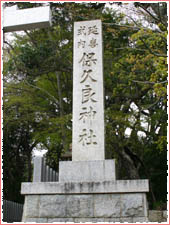
With a history spanning more than a 1000 years, Hokura Shrine is located twenty minutes north of Hankyu Okamoto station halfway up the Mt. Kinchozan (altitude 338 m), a mountain on the Mt. Rokko mountain range. With its panoramic view of Osaka Bay, Hokura Shrine has become a hiking base camp and is a lively area from early morning with its many mountain hikers. In the spring, many people come to see the beautiful plum and cherry blossoms. One particular type of tree that captures people's attention is the weeping cherry blossom tree found on both sides of grounds of the shrine.
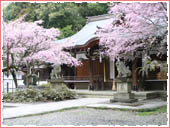
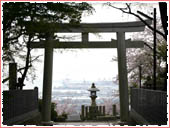
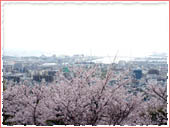
![]()
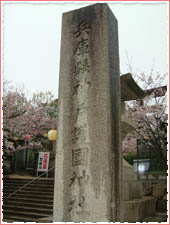
To get to the Gokoku Shrine, take the #2 city bus from the Hankyu Rokko station and get off at Gokoku Jinja-mae. Gokoku shines are in every prefecture and were built as shrines to honor the spirits of local war veterans killed in action. In Hyogo Prefecture there are two Gokoku shrines in Kobe and Himeji. As you walk up the stone steps inside the grounds, there are stone lanterns and festive lanterns that illuminate the cherry trees at night and create a quiet and relaxed atmosphere for viewing cherry blossoms.
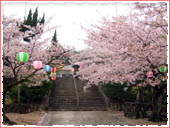
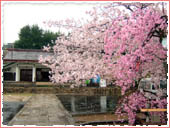

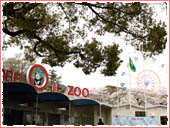
The Kobe Expo was held in 1950 and Oji Park was established on the remains of the grounds. Currently, there is track and field stadium, sports center, a city gallery and a zoo built on the premises. Within the park there are about 700 cherry blossom trees and among these trees there is a cherry blossom tree used as an indicator to predict when cherry trees will blossom in Kobe. Every year during cherry blossom-viewing season, the Oji Zoo is partially opened at night with free admission as a festival and we can see the cherry blossoms lit up at night.

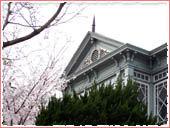
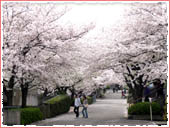
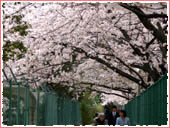
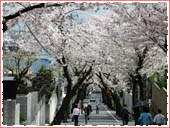
Take the #18 city bus from Sannomiya and get off at Maya Cable. When you go east from the stone step of the Maya Cable station building you will soon run into the Cherry Blossom Tunnel. There are about 70 Somei-yoshino trees lined up on both sides of the 400m path running north-south, and it is certainly worth seeing the gratifying scenery all at one time. Since the city bus takes you right to the site, you can even experience the beauty from inside the bus.
![]()
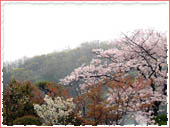
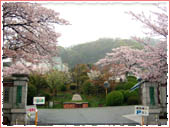
Take the #7 bus from Sannomiya and get off at Kusudani-cho. The waterworks were built in 1917 and in 1989 the building was renovated as a natural museum. The museum not only presents the details of Kobe's water supply, but it is a place to come into contact with the strange properties of water through experiments and practical study and deepen your understanding.
Every year during the cherry blossom season, the museum is open free of charge and you can enjoy looking at about 80 cherry tree line up on the path toward the museum and on the museum grounds.
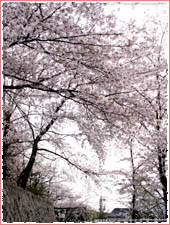
Standing 85 m above sea level, Mt. Egeyama is only a five-minute walk north from the Kamisawa subway station and is widely believed to be the place where Kusunoki Masashige's stationed his army headquarters here during the Battle of Minatogawa in 1336 since the overlook affords a view of the Harima Road, Kobe port, and Suma sea. Within the park's rolling hills, there is a 1km-jogging course in addition to other exercise facilities. The park is a popular place for people to relax. When spring comes, visitors are treated to the beauty of 1,400 cherry blossom trees against the background of the Kobe skyline and sea.
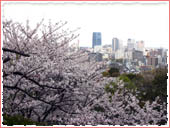
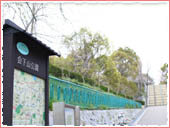
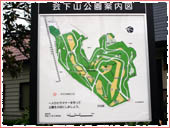
![]()
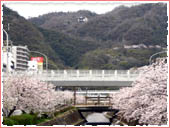
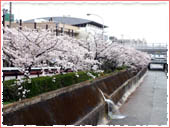
To reach this park, walk south from the Shin-Kobe station (station for the bullet trains) until you reach Route No. 2, which is about a 1 km distance. Here you'll find a beautiful line of cherry trees along the Ikutagawa River. The river flows south from Mt. Maya and Mt. Shakunage of the Rokko mountain range toward the central part of Kobe. Having become a symbol of Kobe, the park has been preserved as an oasis for the Kobe people to enjoy the water and green foliage.
Hanakuma Castle once stood on these grounds. To press his power to the central area of Japan, Oda Nobunaga ordered Araki Murashige, the lord of Itami Castle in Settsu, to build this castle in 1567. Today, over 400 years later, the castle has become a city parking lot with the Hanakuma Park constructed nearby. This park has become a favorite for people to come see cherry blossoms with the Port Tower and Kobe skyline in the background.
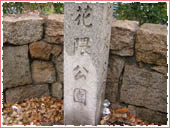
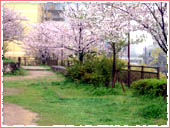
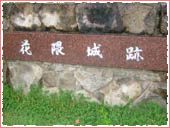
Take city bus #7 from Sannomiya and get off at Suwayama Koen Shita. Near the top of Mt. Suwayama at an altitude about 160 m, there is the Venus Bridge as well as a restaurant, overview area, and parking lot, making it a popular spot for visitors to take a drive. It is a place to enjoy to during the cherry blossom season with a panoramic view of Kobe Port and the city's urban district from the middle of the bridge.
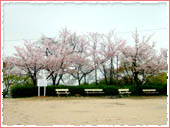
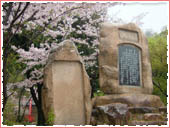

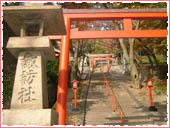
![]()
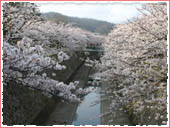
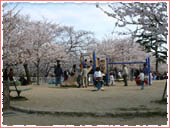
Myohojigawa Park is a three-minute walk southeast of the Higashi Suma station on the Sanyo Railway line. The park is located at the edge of the Myohojigawa River, which passes through this quiet, residential area. From the Itayado station to the Suma Police station, there are nearly 400 cherry blossom trees line up like a cherry tree tunnel Each spring when cherry blossoms bloom, there are many visitors to this famous cherry-viewing spot. In the early summer, there is the sweet fragrance beneath the Japanese wisteria.
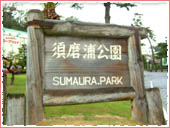
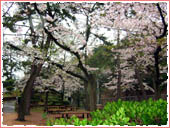
The Sumaura Park is a park rich in nature with a stretch of the Suma beach and Mt. Hachibuse that is famous as an old battle ground for the battle of Ichinotani. From Osaka Bay, you can see the Seto Inland Sea and Awaji Island at various Kobe scenic spots in the area. Since the Manyo period (the 7-8th century) many poets have grown attached to it. Spring comes on the heels of the plum blossoms, and the mountainous area is covered with a variety of cherry blossom trees totaling about 3,200 trees and is famous as a place to see plum and cherry blossoms. Ride the ropeway from Sumaura Park station and you will arrive at Mt. Hachibuse in about 3 minutes. From there, ride the Carlator and sightseeing lift to get to the Sumaura Mountaintop Amusement Park, a popular place with children.
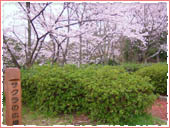
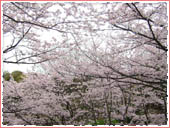
To arrive at Oku-sama Park, take city bus 72 from the Suma station of the Sanyo Railway and get off at Oku-suma Koen Mae. The park will be immediately in front of you. Those using the subway will get off at Myohoji station and walk south for about 15 minutes. The park strives to preserve the richness of nature with a natural forest, ponds in 7 places, terraced rice farming, water flow, and grassy fields. Various living things inhabit the park beginning with 54 types of dragonflies and insects such as fireflies, various birds like Indian Kingfishers and Japanese pigmy woodpeckers.
![]()
Go east from the JR Dojo station, passing through Takarazuka on hiking trail called 'Road of the Sun and Forest' and you will arrive at Sengari Dam. The concrete dam is 42m high and 106 m wide and was completed in 1919. The dam straddles the cities of Mita and Takarazuka and is the largest source of the Kobe's water supply. The sliding gate currently being used is the oldest part of the dam and is registered as an important cultural item.
There is a large field in front of the dam and entrance is strictly prohibited; however, there are 150 cherry trees of 5 varieties and is opened to general admission during the cherry blossom season. Also in the autumn it has a splendid scene of autumn leaves. In 1997, it was selected as one of the New Kobe Top 50 Flower Spots.
